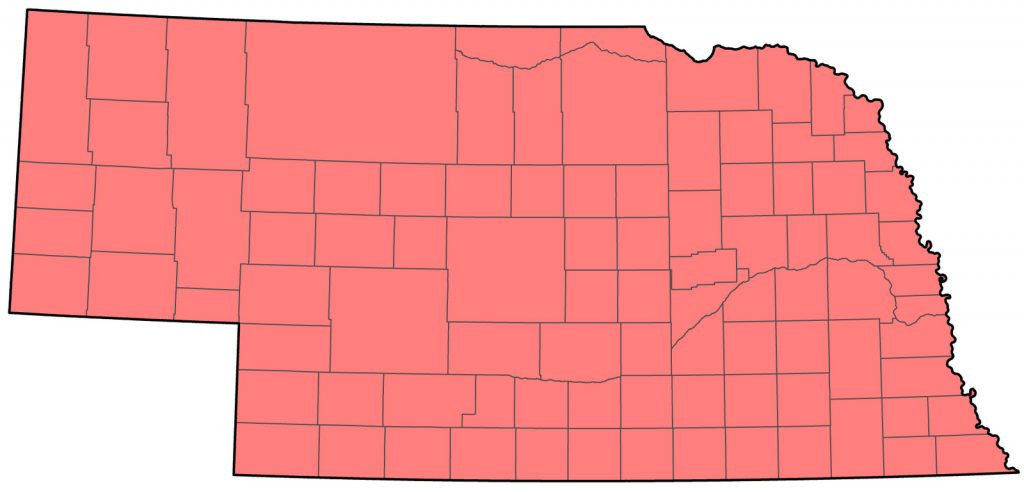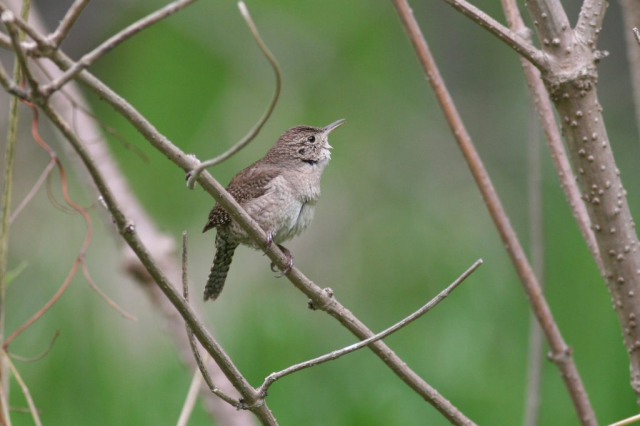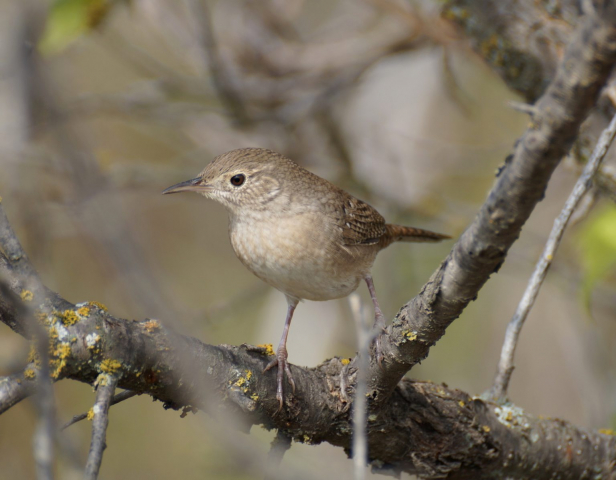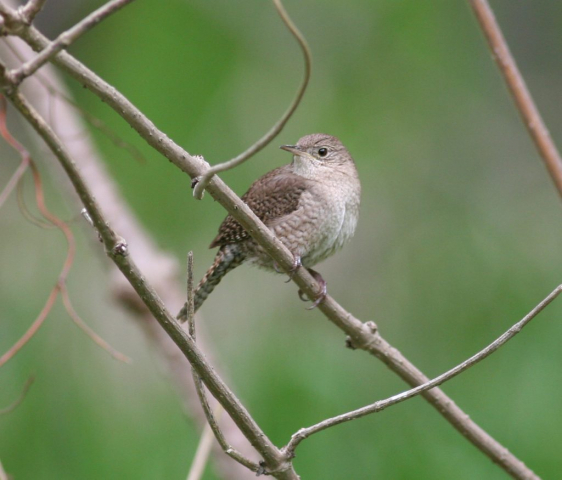Troglodytes aedon parkmanii
Status: Common regular spring and fall migrant and breeder statewide. Accidental in winter.

Documentation: Specimen: UNSM ZM6577, 24 May 1900 Monroe Canyon, Sioux Co.
Taxonomy: The former T. aedon complex of 32 subspecies was split based on genetic, vocal, morphological, and ecological data into seven species (AviList 2025, Chesser et al 2024); the specific epithet aedon was retained for Northern House Wren despite precedence of T. a. domesticus.
Four subspecies are recognized in Northern House Wren (AviList 2025): aedon (includes domesticus and baldwini) of southeast Canada and eastern USA, brunneicollis of central and southern Mexico, cahooni of Arizona into Mexico, and parkmanii of southwest and south-central Canada and west and central USA to northern Mexico.
Nebraska birds are parkmanii (Bruner et al 1904, AOU 1957). Birds in the western parts of the range of parkmanii, formerly designated T. a. baldwini, tend to be somewhat grayer than those further east, although there is considerable variation (Pyle 1997).
Spring: Apr 4, 5, 5 <<<>>> summer
Earlier dates are 14 Mar 2018 Wayne Co (Brogie 2018), and 28 Mar 2011 Sarpy Co. It is likely that reports earlier than these are of misidentified Winter Wrens; overwintering of House Wren has not been documented in Nebraska. One was reported attending a feeder in Red Willow Co 8-15 Feb 2012, the only Feb record for the state.
That the earliest birds are migrants and not arriving summer residents is suggested by the one-month gap in early arrival dates and early egg dates (see Breeding Phenology). South Dakota data show a similar differential (Tallman et al 2002). Females arrive around nine days after males and begin nesting immediately (Johnsgard 1979), suggesting that their mates arrive about 10 days earlier, or mid- to late Apr. First-time breeders may not arrive on nesting territories until mid-to late June (Kendeigh 1941, Johnson 2020). Such birds may account for records of two banded in Nebraska in May 1985 being recaptured in North Dakota and Alberta in Jul 1985.
A study by Jorgensen and Brenner (2024) found that spring arrival dates had advanced by six days from 1938 to 2024.
- High counts: 351 in Pierce Co 8 May 1999, 302 in Hall Co 11 May 2002, and 224 in Sarpy Co 11 May 1996, 167 of which were at Fontenelle Forest, Sarpy Co.
- One person, one location high counts are 300 at DeSoto NWR, Washington Co 6 May 2017, 175 at Wilderness Park, Lancaster Co 11 May 2021, and 150 there 8 May 2020.
Summer: House Wren breeds statewide, although data for 2011-2015 show lower densities in the southern Panhandle and in the Sandhills (Sauer et al 2017), presumably since there is less suitable habitat. Two BBS routes in Cherry Co were run twelve times with no House Wrens recorded (Cortelyou 1978), although numbers have increased in the northern Sandhills 1966-2015 (Sauer et al 2017). This species is ubiquitous in open woodland in the east; elsewhere, it occupies riparian woodland and residential areas wherever brushy cover exists. BBS trend analysis (Sauer et al 2020) show House Wren has changed 0.47% (95 C.I.; -0.11, 1.04) annually statewide 1966-2019, indicating populations have remained relatively stable or increased slightly during the period.
Summering birds show strong site fidelity, especially successful males (Johnson 2020).
- Breeding phenology:
Nest building: 28 Apr-8 Jul
Eggs: 29 Apr-28 Jul
Nestlings: 3 May-29 Jul
Fledglings: 7 May-13 Sep
A pair used two of three bird houses intended for chickadees to fledge four broods near Mitchell, Scotts Bluff Co in 2012, three from one house and one from the second. A pair nested in a nest box that had just fledged Black-capped Chickadees in Lincoln 1 Jul. “Perhaps a third brood” was in a Fillmore Co yard 11 Aug.
- High counts: 97 at Rock Creek SRA, Dundy Co 18 Jul 2020, 85 at Sowbelly Canyon, Sioux Co 24 Jun 2024, 76 there 5 Jun 2023, 63 at Red Willow Reservoir, Frontier Co 30 Jun 2002, 63 at Rock Creek SRA 11 Jul 2022, and 62 at Wilderness Park, Lincoln 26 Jun 2010.
Fall: summer <<<>>> Oct 23, 23, 25
Later dates are 30 Oct 2006 (3) Nebraska City, Otoe Co, 2 Nov 1996 Nebraska City, 21 Oct-4 Nov 2024 Lincoln, Lancaster Co, 5 Nov 1986 Lancaster Co, 6 Nov 2023 Omaha, Douglas Co, 8 Nov 2010 (2) Dixon Co, 11 Nov 1998 Otoe Co (Falk 2002), and 2 Dec 2019 Lancaster Co. One found on the Hastings, Adams Co CBC 1 Jan 1957 was considered “… unbelievable date … but a quick note and answer from Burton Nelson shows this is no mistake” (Bliese 1957).
Departure is usually complete by mid-Oct.
House Wrens winter as far north as southeast Oklahoma and central Arkansas (Johnson 2020). Great Plains breeders apparently migrate southeast to the southeast United States (Johnson 2020).
- High counts: 48 at Rock Creek SRA, Dundy Co 9 Aug 2020, 44 along Road 44 in southeastern Garden Co 4 Sep 2020, 34 at Rock Creek SRA, Dundy Co 1 Sep 2019, 33 there 30 Aug 2021, and 33 at Lake Ogallala, Keith Co 7 Aug 2024.
Winter: There is a single record for midwinter (Jan-Feb), of one recorded 20 Feb 2024 in Omaha, Douglas Co.
Comments: Prescribed fire and thinning is increasingly being used to actively manage oak woodlands due to concerns that suppression of these disturbance regimes impairs oak regeneration and promotes the spread of invasive and/or undesirable species. Sites where active management has recently occurred include Indian Cave and Ponca State Parks (Nemaha/Richardson and Dixon Cos respectively) and Fontenelle Forest. Active management, however, affects avian communities and species disproportionately, with some species benefiting while others experience negative impacts. Abundance of House Wren, along with Carolina Wren and Eastern Towhee, at Indian Cave SP was relatively low following and possibly because of recent active management in the park (Jorgensen et al 2014).
Images
Abbreviations
BBS: Breeding Bird Survey
CBC: Christmas Bird Count
NWR: National Wildlife Refuge
SP: State Park
SRA: State Recreation Area
UNSM: University of Nebraska State Museum
Literature Cited
American Ornithologists’ Union [AOU]. 1957. The AOU Check-list of North American birds, 5th ed. Port City Press, Baltimore, Maryland, USA.
AviList Core Team, 2025. AviList: The Global Avian Checklist, v2025. https://doi.org/10.2173/avilist.v2025.
Bliese, J.C.W. 1957. Thirty-third Annual Cooperative Spring Migration and Occurrence Report. NBR 25: 51-72.
Brogie, E. 2018. Checklist S43656058: Wayne US-NE. eBird.org, accessed 5 Jul 2018.
Bruner, L., R.H. Wolcott, and M.H. Swenk. 1904. A preliminary review of the birds of Nebraska, with synopses. Klopp and Bartlett, Omaha, Nebraska, USA.
Chesser, R.T., S.M. Billerman, K.J. Burns, C. Cicero, J.L. Dunn, B.E. Hernandez-Banos, R.A. Jimenez, O. Johnson, A.W. Kratter, N.A. Mason, P.C. Rasmussen, and J. V. Remsen, Jr. 2024. Sixty-fifth Supplement to the American Ornithologists’ Union Check-list of North American Birds. Ornithology 141. https://doi.org/10.1093/ornithology/ukae019.
Cortelyou, R.G. 1978. The first eleven years of Breeding Bird Surveys in Nebraska. NBR 46: 38-62.
Falk, L. 2002. Birds in Otoe County. Published by the author, Nebraska City, Nebraska, USA.
Johnsgard, P.A. 1979. Birds of the Great Plains: breeding species and their distribution. University of Nebraska Press, Lincoln, Nebraska, USA.
Johnson, L.S. 2020. House Wren (Troglodytes aedon), version 1.0. In Birds of the World (A. F. Poole, Editor). Cornell Lab of Ornithology, Ithaca, NY, USA. https://doi.org/10.2173/bow.houwre.01.
Jorgensen, J.G., and S.J. Brenner. 2024. The changing spring migration patterns of selected bird species in Nebraska 1938-2024. Joint Report of the Nongame Bird Program at the Nebraska Game and Parks Commission and Audubon Great Plains, Lincoln, Nebraska, USA.
Jorgensen, J.G., L.R. Dinan, M.A. Brogie, W.R. Silcock, J. Rink, C. Klaphake, and G. Steinauer. 2014. Breeding Bird Diversity, Abundance and Density at Indian Cave and Ponca State Parks, Nebraska, 2012-2014. Nongame Bird Program of the Nebraska Game and Parks Commission, Lincoln, Nebraska, USA.
Kendeigh, S.C. 1941. Territorial and mating behavior of the House Wren. Illinois Biological Monographs 18: 1-120.
Pyle, P. 1997. Identification Guide to North American Birds. Part I, Columbidae to Ploceidae. Slate Creek Press, Bolinas, California, USA.
Sauer, J.R., D.K. Niven, J.E. Hines, D.J. Ziolkowski, Jr, K.L. Pardieck, J.E. Fallon, and W.A. Link. 2017. The North American Breeding Bird Survey, Results and Analysis 1966 – 2015 (Nebraska). Version 2.07. USGS Patuxent Wildlife Research Center, Laurel, Maryland, USA.
Sauer, J.R., W.A. Link and J.E. Hines. 2020. The North American Breeding Bird Survey – Analysis Results 1966-2019. U.S. Geological Survey data release, https://doi.org/10.5066/P96A7675, accessed 27 Jul 2023.
Tallman, D.A., Swanson, D.L., and J.S. Palmer. 2002. Birds of South Dakota. Midstates/Quality Quick Print, Aberdeen, South Dakota, USA.
Recommended Citation
Silcock, W.R., and J.G. Jorgensen. 2025. House Wren (Troglodytes aedon). In Birds of Nebraska — Online. www.BirdsofNebraska.org
Birds of Nebraska – Online
Updated 9 Sep 2025



